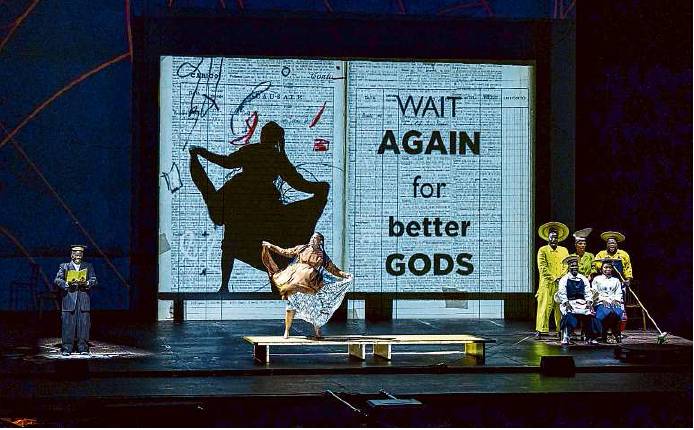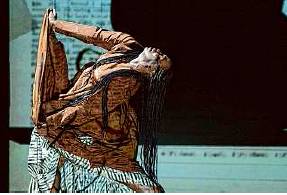‘Sibyl’ spreads joy and mystery in its U.S. premiere
Multimedia extravaganza dares audiences to keep up
By Joshua Kosman
According to ancient Greek mythology, the Cumaean Sibyl was an oracle who would truthfully answer any question presented to her. But there was no guarantee that the response you received would match the question you had asked.
The same spirit of elusive, contrary wisdom swirls around “Sibyl,” the beguiling and feverishly beautiful multimedia extravaganza that had its U.S. premiere on Friday, March 17, in the first of three performances at UC Berkeley’s Zellerbach Hall.
The 90-minute work is the creation of the polymathic South African artist William Kentridge in collaboration with the 10 members of its performing ensemble, all of them partners in his Johannesburg studio. “Sibyl” challenges you to make rational sense of its imagery even as it tickles your sensory receptors into a state of helpless euphoria.
“What does it all mean?” may well have an answer. But it’s also probably not the question you want to ask — at least not at first.
Instead, start by surrendering to the sensual delights of this cornucopia of sound and sight, combining film, music, dance, drawing, physical slapstick and a terse verbal text composed of winsome epigrams.
Kentridge has termed “Sibyl” an opera, but that is clearly just a catchall designation. Like a three-ring circus, the piece operates on so many channels at once that sometimes the challenge is simply to keep up.
Kentridge’s distinctive brand of animated film, painstakingly assembled from countless hand-drawn figures in pencil, ink and charcoal, forms an almost constant backdrop. Inkblots become trees, which become birds, which in turn fade out or wheel away into some putative sky.
There is music by pianist Kyle Shepherd and vocalist Nhlanhla Mahlangu, which ranges from exquisite choral tapestries of multipart harmony to jazzy, angular keyboard riffs. Dancer Teresa Phuti Mojela evokes the Sibyl by hurling herself into breathlessly ecstatic coils of frenzied motion.
In one uproarious scene that plays like an homage to the silent film star Buster Keaton, performer Thulani Chauke finds himself surrounded by chairs that slide away or collapse when he’s not looking. In another, a janitor sweeping paper from the floor finds that he can hear the writers’ voices singing to him when he puts a page to his ear. There are intricate pas de deux between actors and their shadows, and deliriously colored costumes by Greta Goiris.
Through it all, Kentridge’s little sayings flit across the film screen like verbal origami. “I no longer believe what I once believed,” reads one. “It reminds me of something I can’t remember,” says another.
These sentences turn on each other in the same way that certain sculptures of Alexander Calder, which served as an original inspiration for “Sibyl,” rotate to reveal hidden imagery and then obscure them again. But they also hint at the piece’s thematic underpinnings.
Most germane, perhaps, is “Heaven is talking in a foreign tongue” — a reminder that even if the messages of the gods seem opaque to us, that doesn’t make them any less real.
This is a notion that has tendrils of connection to much of Kentridge’s work, which makes “Sibyl” a fitting centerpiece of Kentridge’s extended residency at UC Berkeley, co-sponsored by Cal Performances, the Berkeley Art Music and Pacific Film Archive, and the Townsend Center for the Humanities.
On March 10, for example, Kentridge got his visit under way with a virtuoso rendition of “Ursonate” (“Primal Sonata”), the 1932 sound poem by the Dadaist Kurt Schwitters that turns a rigorously structured series of spoken nonsense syllables into a kind of sculpture — grammatical language by alternate means. (Film screenings, art exhibits and public conversations are scheduled through April 13.)
Performing the work of other artists in that way is a sideline for Kentridge, who began his career as an actor but discovered he lacked either the temperament or the talent for it. But his own creations investigate many of the same concerns.
“Sibyl” is a consummate example. It’s an exuberant celebration of movement, music, philosophy and joy, in which sense and sensuality become inextricably entwined.
Reach Joshua Kosman: jkosman@sfchronicle.com; Twitter: @JoshuaKosman
"SIBYL": 8 p.m. Saturday, March 18; 3 p.m. Sunday, March 19. $42-$125. Zellerbach Hall, UC Berkeley. 510-642-9988. www.calperformances.org



